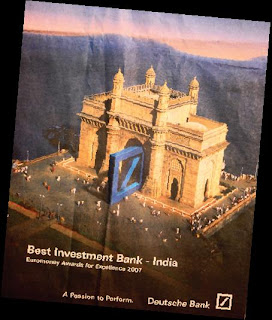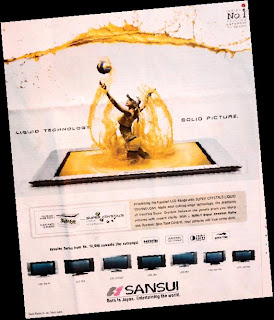IIPM Ranked No. 1 B-School In Global Exposre - Zee...
For Motorola, the sad story has begun. The only remedy to revive the cellular giant is to finally get over its RAZR mania and get on with innovative offerings. It has done this before and there’s no reason to believe that it can’t unlock its magic box, yet again...
Motorola’s new CEO, Greg Brown, should have learnt a lot from his predecessors, the two CEO’s before him who got caught into the congestion of the wireless industry that cost them their jobs. Is history about to repeat itself, what with the intensity of problems much higher this time and the cut definitely deeper with a visible slump in telecom industry and the ever-continuing woes of Motorola? Brown is under constant pressure from his shareholders to chop off its loss-making mobile handset unit as, for the first time in decades, Motorola’s stock has plummeted below $10 a share.
But another lesson from history tells us that Motorola has almost always managed to stay afloat even during the worst of storms. Motorola’s image and brand name has long been associated with mobile handsets, as Jeff Kagan, telecom expert puts it, “Motorola was always the handset-maker. It lost that in the 90’s to Nokia, when the networks switched from analog to digital. Motorola’s last hot phone was the StarTac in the mid 1990s until it came out with the Razr in the 2000s. Unfortunately, it had no products to follow the Razr. So, it rode the wave up and back down again.” Brown has enough credentials and exposure to be trusted with a sinking ship, as he was the one who led Motorola to the second-largest acquisition ($3.9 billion) of Symbol Technologies. In addition, he was responsible for the divesture of flailing automotive division to Continental for $1 billion.
Brown has shown personal interest to somehow revive the handset division, but he might have to still give uop due to intense pressure from investors, especially billionaire Carl Icahn, who recently increased his share by 1.5% to 6.5% in Motorola, and who has recommended a slew of names for prospective board candidates. Caught between two pressing situations, Brown intends to sell off the cascading division but it’s going to be an uphill task as the division suffered heavy operating losses to the tune of $1.2 billion in 2007. Competitors like Nokia, Samsung and LG Electronics, who are biting off Motorola’s market share, and are clearly not interested in buying an ailing division.
The downhill slope of the telecom sector is easy to predict even with the global mobile phone industry recording a prodigious sales target of 1.15 billion units in 2007 as compared to 990 million units in 2006, a stupendous growth of 16% as per Gartner Inc. The fact is that it’s becoming growingly impossible to ignore that the sector is giving out strong and sure hints of a slowdown. The piercing winds of biting frost are blowing hard in the once scorching telecom sector. For example, both Mitsubishi and Sanyo Electric having announced that they would surely dispose off their unprofitable mobile phone businesses.
Having reached its peak of 31% growth rate in 2004, mobile industry has treaded downhill ever since, with analysts forecasting a dwindling down of the growth rate to 15% in 2008. The reasons can be easily pinned down to the slowing economy, a maturing market and the alarm bells being sounded by telecos. Recently, Texas Instruments, the chip-making giant, was forced to adjust its guidance for the present quarter (Q1, 2008) to about half of its previous range because of an expectation that Nokia might reduce its chip orders due to an inventory pile-up. The San Diego-based wireless giant, Qualcomm, too sent out signals that the industry was facing a tough year; it decided to buy back stocks worth $2 billion on top of an almost $3 billion buyout recently. If that’s not enough, here’s more: Sony Ericson, the number four player in the mobile handset category, predicted a deep cut in its current quarter pretax profits from $571 million recorded last year to about $276 million. But this downward adjustment can be somewhat accounted for as sales are always lower after Christmas, the shopping season. But the size of the shortfall does suggest dangerous times ahead, putting the focus on Nokia and even more pressure on maladroit Motorola, whose dwindling profits forced it to give up its number two position to Samsung. The recent chaos seems to push it further into an abyss with strong indications that it will slip down to number four position recently occupied by Sony Ericsson by the end of this year. In the past year, Motorola could only achieve sales of 164,307 million phones as compared to Nokia’s 435,453 units, thus achieving its long-stated target of 40%. According to Dataquest Insight: Market Share for Mobile Devices, 4Q07 and 2007, the amplitude of Motorola’s troubles is depicted by the 9.7% market share drop in its year-end quarter of 2007 as compared to 2006. If the trend repeats this year, with a repeat of 27% decline, what with a non impressive line-up of phones, Motorola will only manage to sell 116 million units.
What Motorola needs now are not history lessons but children’s book. Brown needs to don the cap of Willy Wonka, a character made famous by Roald Dahl, and come out with products as unparalleled as Wonka’s famous candy eggs that hatch chocolate chip birds which can move and chirp, and leave behind the done-to-death success of Razor to rewrite history.
Priyanka Rajpal
For more articles, Click on IIPM Article.
Source : IIPM Editorial, 2008
An Initiative of IIPM, Malay Chaudhuri and Arindam chaudhuri (Renowned Management Guru and Economist).
Read these article :-
ZEE BUSINESS BEST B SCHOOL SURVEY
B-schooled in India, Placed Abroad (Print Version)
IIPM in Financial times (Print Version)
IIPM makes business education truly global
The Indian Institute of Planning and Management (IIPM)
IIPM Campus
For More IIPM Info, Visit below mentioned IIPM articles.
4Ps Power Brand Awards 2007
When IIPM comes to education, never compromise
IIPM, GURGAON
IIPM - Admission Procedure
IIPM is A World of Career
Why Study Abroad When IIPM Gives You 3 global Advantages!

 Yamaha RX100 was the product to own, way back in the 1980s. Back then if you were a young, hip and adrenaline pumping youngster, the Yamaha was an almost prerequisite accoutrement. Japanese major Suzuki (with high performance bikes) was also on a roll in India at one time, in collaboration with TVS. But that was then. Enter huge hikes in fuel prices, Euro norms and indigenous manufacturers, willing and able competitors in fuel efficient products, stole the thunder from under the Jap majors’ feet. Performance-oriented products were fast forgotten. Hero Honda catapulted itself to the numero uno position on the back of its super successful crop of fuel efficient bikes (Splendor), while Bajaj brought the volumes (piggybacking the CT100). Yamaha, Honda, Suzuki tried to fight back with their version of fuel efficient bikes but could not match them. A look at the sales between April and September 2007-08 for independent foreign bike makers (Yamaha, Suzuki and Honda – now predominantly selling fuel efficient bikes) will tell the rest – a combined 518,139 units, 59% of the total units sold by just Bajaj in the same period!
Yamaha RX100 was the product to own, way back in the 1980s. Back then if you were a young, hip and adrenaline pumping youngster, the Yamaha was an almost prerequisite accoutrement. Japanese major Suzuki (with high performance bikes) was also on a roll in India at one time, in collaboration with TVS. But that was then. Enter huge hikes in fuel prices, Euro norms and indigenous manufacturers, willing and able competitors in fuel efficient products, stole the thunder from under the Jap majors’ feet. Performance-oriented products were fast forgotten. Hero Honda catapulted itself to the numero uno position on the back of its super successful crop of fuel efficient bikes (Splendor), while Bajaj brought the volumes (piggybacking the CT100). Yamaha, Honda, Suzuki tried to fight back with their version of fuel efficient bikes but could not match them. A look at the sales between April and September 2007-08 for independent foreign bike makers (Yamaha, Suzuki and Honda – now predominantly selling fuel efficient bikes) will tell the rest – a combined 518,139 units, 59% of the total units sold by just Bajaj in the same period! JV between ICICI Bank and Canada-based $26 billion Fairfax Financial Holdings is creating ripples in the general insurance sector. Sandeep Bakhshi, MD & CEO, ICICI Lombard General Insurance (ILGI), said, “We will be focusing on health in a major way. We will be launching new health products, increasing distribution and enrolling more hospitals. The health insurance portfolio will be witnessing a substantial increase.” ILGI is laying its bet on using Internet and telephone connections to get in touch with new retail customers. Customers buying retail policies in areas such as motor, home, travel and health (both critical illness and personal accident) will be offered the products through these mediums. “Currently, e-channel brings in less than 1% of our premium income, but we believe that this number can easily grow to over 20% over the next four to five years,” said Kartik Jain, head of marketing and e-channel, ILGI. This ISO 9001:2000 certified company is surely planning for a comprehensive product line – more to pep up its confidence, it won the ‘General Insurance Company of the Year’ award at the 11th Asia Insurance Industry Awards 2007. But will internet connections really pick the way it has done in China? And by when? More importantly, will Indians buy insurance products online, considering that most experts feel that this business is a purely on developing personal, long-term relationships?
JV between ICICI Bank and Canada-based $26 billion Fairfax Financial Holdings is creating ripples in the general insurance sector. Sandeep Bakhshi, MD & CEO, ICICI Lombard General Insurance (ILGI), said, “We will be focusing on health in a major way. We will be launching new health products, increasing distribution and enrolling more hospitals. The health insurance portfolio will be witnessing a substantial increase.” ILGI is laying its bet on using Internet and telephone connections to get in touch with new retail customers. Customers buying retail policies in areas such as motor, home, travel and health (both critical illness and personal accident) will be offered the products through these mediums. “Currently, e-channel brings in less than 1% of our premium income, but we believe that this number can easily grow to over 20% over the next four to five years,” said Kartik Jain, head of marketing and e-channel, ILGI. This ISO 9001:2000 certified company is surely planning for a comprehensive product line – more to pep up its confidence, it won the ‘General Insurance Company of the Year’ award at the 11th Asia Insurance Industry Awards 2007. But will internet connections really pick the way it has done in China? And by when? More importantly, will Indians buy insurance products online, considering that most experts feel that this business is a purely on developing personal, long-term relationships?




